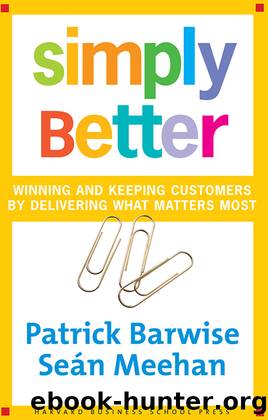Simply Better by Barwise Patrick;Meehan Sean; & Seán Meehan

Author:Barwise, Patrick;Meehan, Sean; & Seán Meehan [Barwise]
Language: eng
Format: epub
ISBN: 9781633692800
Publisher: Lightning Source Inc. (Tier 2)
Published: 2016-09-13T00:00:00+00:00
Using the Internet to Be Simply Better
Radical thinking and pushing the limits are great in the right context. In golf, backspin is good; straight is better. As a rule, we would be worried if executives were spending more than 10 percent of their time dreaming up the next breakthrough. Further, we believe that one way to think about getting the most out of that 10 percent is to spend much of it scanning new entrants, especially those smaller companies that, not burdened with thinking about your market the way you have for decades, seem to be making something of an impact, gaining attention and customer acceptance. As we have seen, in reality it is the alert, well-capitalized, simply better second movers, not the real pioneers, that usually capture most value from such radical innovations. Finally, while we acknowledge the success of some such flanking strategies, we are loath to recommend flanking as a normal growth strategy.
The Internet provides many examples of businesses using technology to be simply betterâand quite a few of companies falling in love with technology and forgetting about customersâ real needs.
Writing in 2004, it is no longer controversial that many of the failed dotcoms were based on business models that could never work because the value proposition made no sense to customers. In contrast, a few well-known Internet start-ups have survived to create strong brands and viable businesses. Examples include eBay, Amazon.com, Yahoo!, and Google. All of them combine a service that meets real customer needs (e.g., reduced search costs) with outstanding execution and attention to the basics. For instance, Amazon is so good at logistics that Toys âR Us, having failed to deliver toys in time for Christmas 1999, went to the Web retailer for online ordering and fulfillment functionality.26
Most successful use of the Internet, however, is by established companies using it to be simply better, mainly through improved customer service and internal and value chain efficiencies. In the early days, companies mainly emphasized direct e-commerce, often trying to cut out a middleman, a process called âdisintermediation.â For instance, companies such as Saturn, Reebok, Levi Strauss, and A.B.Dick, a maker of printing press equipment, tried to sell direct, in some cases using mass customization to tailor their products for individual customers. These efforts usually proved to be uneconomical as well as to have created conflict with existing channels. Most have been abandoned or drastically scaled back. Of course, e-commerce is growing but usually as a supplement to existing channels. Most of the biggest e-commerce success stories are about companies such as Dell, Ryanair, easyJet, and Tesco.com, who were already selling direct using traditional channels, including the telephone or brick-and-mortar stores.27
Today, most companies with established channels use the Internet not to bypass those other channels but instead to strengthen relationships with them, as well as with suppliers and final customers. For instance, Saturn has a program to help its dealersâsome of which were still not using e-mail in late 2002âto use technology to improve their customer service and communications.
Download
This site does not store any files on its server. We only index and link to content provided by other sites. Please contact the content providers to delete copyright contents if any and email us, we'll remove relevant links or contents immediately.
Hit Refresh by Satya Nadella(9040)
The Compound Effect by Darren Hardy(8815)
Change Your Questions, Change Your Life by Marilee Adams(7637)
Nudge - Improving Decisions about Health, Wealth, and Happiness by Thaler Sunstein(7622)
The Black Swan by Nassim Nicholas Taleb(7016)
Deep Work by Cal Newport(6885)
Daring Greatly by Brene Brown(6449)
Rich Dad Poor Dad by Robert T. Kiyosaki(6413)
Principles: Life and Work by Ray Dalio(6221)
Playing to Win_ How Strategy Really Works by A.G. Lafley & Roger L. Martin(5931)
Man-made Catastrophes and Risk Information Concealment by Dmitry Chernov & Didier Sornette(5924)
Digital Minimalism by Cal Newport;(5667)
Big Magic: Creative Living Beyond Fear by Elizabeth Gilbert(5615)
The Myth of the Strong Leader by Archie Brown(5427)
The Slight Edge by Jeff Olson(5352)
Discipline Equals Freedom by Jocko Willink(5287)
The Motivation Myth by Jeff Haden(5157)
Stone's Rules by Roger Stone(5027)
The Laws of Human Nature by Robert Greene(5001)
